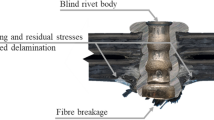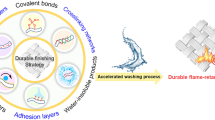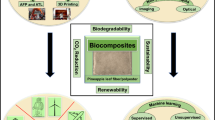Abstract
Infrared thermography was used to study damage developing in woven fabrics. Two different experiments were performed, a ±45° tensile test and a rail shear test. These two different types of tests show different damage scenarios, even if the shear stress/strain curves are similar. The ±45° tension test shows matrix hardening and matrix cracking whereas the rail shear test shows only matrix hardening. The infrared thermography was used to perform an energy balance, which enabled the visualization of the portion of dissipated energy caused by matrix cracking. The results showed that when the resin is subjected to pure shear, a larger amount of energy is stored by the material, whereas when the resin is subjected to hydrostatic pressure, the main part of mechanical energy is dissipated as heat.

















Similar content being viewed by others
References
Pandita SD et al (2001) Tensile fatigue behaviour of glass plain-weave fabric composites in on- and off-axis directions. Compos A 32(10):1533–1539
John S et al (2001) Longitudinal and transverse damage taxonomy in woven composite components. Compos B 32(8):659–668
Osada T et al (2003) Initial fracture behavior of satin woven fabric composites. Compos Struct 61(4):333–339
Daggumati S et al (2010) Local damage in a 5-harness satin weave composite under static tension: part I—experimental analysis. Compos Sci Technol 70(13):1926–1933
Vieille B et al (2014) Influence of matrix toughness and ductility on the compression after impact behavior of woven-ply thermoplastic and thermosetting composites: a comparative study. Compos Struct 110:207–218
Soumahoro Z (2005) Etude du couplage thermomécanique dans la propagation dynamique de fissure. Université à Palaiseau, Ecole Polytechnique, Palaiseau
Lisle T et al (2013) Damage analysis and fracture toughness evaluation in a thin woven composite laminate under static tension using infrared thermography. Compos A 53:75–87
Lisle T et al (2015) Measure of fracture toughness of compressive fiber failure in composite structures using infrared thermography. Compos Sci Technol 112:22–33
Freund LB, Hutchinson JW (1985) High strain-rate crack-growth in rate-dependent plastic solids. J Mech Phys Solids 33(2):169–191
Taylor GI, Quinney H (1934) The latent energy remaining in a metal after cold working. In: Royal society A: mathematical, physical and engineering sciences
Rittel D (1999) On the conversion of plastic work to heat during high strain rate deformation of glassy polymers. Mech Mater 31(2):131–139
Li ZH, Lambros J (2001) Strain rate effects on the thermomechanical behavior of polymers. Int J Solids Struct 38(20):3549–3562
Benevolenski OI et al (2003) Mode I fracture resistance of glass fibre mat-reinforced polypropylene composites at various degree of consolidation. Compos A 34(3):267–273
Rouault T et al (2013) Reversible rail shear apparatus applied to the study of woven laminate shear behavior. Exp Mech 53(8):1–12
Bizeul M (2009) Contribution à l’étude de la propagation de coupure en fatigue dans les revêtements composites tissés minces. Université de Toulouse, Toulouse
Bizeul M et al (2011) Fatigue crack growth in thin notched woven glass composites under tensile loading. Part I: experimental. Compos Sci Technol 71(3):289–296
Bizeul M et al (2011) Fatigue crack growth in thin notched woven glass composites under tensile loading. Part II: modelling. Compos Sci Technol 71(3):297–305
Gao F et al (1999) Damage accumulation in woven-fabric CFRP laminates under tensile loading: part 1. Observations of damage accumulation. Compos Sci Technol 59(1):123–136
Kergomard YD et al (2010) Intralaminar and interlaminar damage in quasi-unidirectional composite structures: experimental analysis. Compos Sci Technol 70(10):1504–1512
Alif N, Carlsson LA (1997) Failure mechanisms of woven carbon and glass composites. ASTM Spec Tech Publ 1285:471–493
D3518/D3518M-13, 2001 Standard test method for in-plane shear response of polymer matrix composite materials by tensile test of a ±45° laminate. ASTM International
Lessard LB, Eilers OP, Shokrieh MM (1997) Modification of the three-rail shear test for composite materials under static and fatigue loading. ASTM Spec Tech Publ 1242:217–233
De Greef N, Gorbatikh L, Lomov SV, Verpoest I (2011) Damage development in woven carbon fibre/epoxy composites modified with carbon nanotubes under tension in the bias direction. Compos A 42(11):1635–1644
Couégnat G (2008) Approche multiéchelle du comportement mécanique de matériaux composites à renfort tissé. Université Sciences et Technologies-Bordeaux I, Bordeaux
Karahan M (2011) Investigation of damage initiation and propagation in 2 × 2 twill woven carbon/epoxy multi-layer composites. Text Res J 81(4):412–428
Lemaignan C (2003) La Rupture des matériaux. Les Ulis (Essonne), EDP sciences
Fiedler B et al (2001) Failure behavior of an epoxy matrix under different kinds of static loading. Compos Sci Technol 61(11):1615–1624
Emery TR et al (2008) A generalised approach to the calibration of orthotropic materials for thermoelastic stress analysis. Compos Sci Technol 68(3–4):743–752
Trojanowski A, Ruiz C, Harding J (1997) Thermomechanical properties of polymers at high rates of strain. J Phys IV France 7(C3):447–452
Acknowledgements
The authors wish to thank the “Ecole Nationale d’Ingénieur de Tarbes” for the loan of the infrared camera.
Author information
Authors and Affiliations
Corresponding author
Rights and permissions
About this article
Cite this article
Lisle, T., Bouvet, C., Pastor, M.L. et al. Damage of woven composite under tensile and shear stress using infrared thermography and micrographic cuts. J Mater Sci 50, 6154–6170 (2015). https://doi.org/10.1007/s10853-015-9173-z
Received:
Accepted:
Published:
Issue Date:
DOI: https://doi.org/10.1007/s10853-015-9173-z




